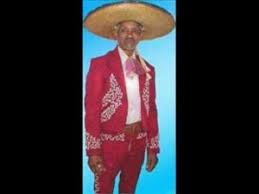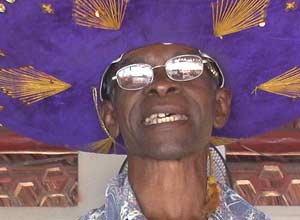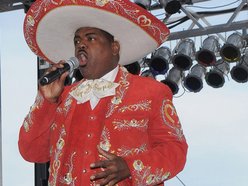 EL CHARRO NEGRO CUBANO, UN PERSONAJES DEL SURREALISMO TROPICAL.
EL CHARRO NEGRO CUBANO, UN PERSONAJES DEL SURREALISMO TROPICAL.
Se presenta como el único cantante negro de rancheras y dice que se siente mexicano por fuerza y corazón, aunque lleva al cinto una pistola con el detalle de la mano de Orula: Franklyn Delano Smith es todo un descubrimiento en la galería de personajes del surrealismo tropical.
“Me siento ranchero, me siento mexicano y doy mi vida por la música ranchera”, repite Smith, protagonista del documental El Charro Negro (2012), de los realizadores Diego Enríquez (México), Margarita González (Colombia) y Carmen Romero (Cuba).
Rodado en la playa de Baracoa, al oeste de La Habana, el filme de siete minutos es resultado de un taller de Realización Documental, organizado por la Escuela Internacional de Cine y Televisión de San Antonio de los Baños con los auspicios de la Fundación del nuevo Cine Latinoamericano.
Smith, apodado el Charro Negro, recorre el poblado con su guitarra y sus tonadas, y cuenta su singular historia de mexicanidad adoptada.
“Dicen que nunca han visto un mexicano negro, pues ya lo estás viendo…”, afirma el cantante, que es oriundo de Palmarito de Cauto, en el oriente cubano.
.. En su atuendo ha incorporado una pistola que dice “de origen bantú” con una incrustación de la mano de Orula en la cacha, y que “siempre va conmigo”.
“Es un personaje sencillamente fascinante”, dijo el actor y cantante de música campesina Ramón Veloz, quien descubrió a Smith viendo el documental para una presentación en AmericaTeve-Canal 41 de Miami.
Veloz, que proviene de una emblemática familia de cultores de la música campesina, recordó que tradicionalmente ha existido un gran arraigo de rancheras y corridos mexicanos en el campo cubano, especialmente en las zonas de Pinar del Río y las provincias centrales del país.
Programas en la radio cubana como “De México, sus canciones”, en la emisora provincial Radio Sancti Spíritus, mantienen una programación diaria con los géneros tradicionales mexicanos.
Pero Smith no parece ser el único charro negro del país. En la provincia Granma vive otro cantante de los géneros folclóricos mexicanos, Luis Rey Palmero, conocido por el mismo alias artístico. Lo cierto es que la fabulación mexicana de El Charro Negro ha calado hondo en Smith.
“Soy mexicano de fuerza y de corazón”, asevera el cantante mientras se pasea todos los días por los ranchones de Playa Baracoa o mas exacto si lo quiere encontrar seguro en el restaurant chino del Villa Victoria. Un adios momentaneo a este gran personaje amante de la hermosa música del hermano México.
 THE CUBAN “BLACK CHARRO”, A CHARACTER OF THE TROPICAL SURREALISM.
THE CUBAN “BLACK CHARRO”, A CHARACTER OF THE TROPICAL SURREALISM.
He is presented as the only black ranchera singer and says that he feels Mexican by strength and heart, although his belt is a pistol with the detail of the hand of Orula: Franklyn Delano Smith is a discovery in the gallery of characters of tropical surrealism.
“I feel like a rancher, I feel Mexican and I give my life for ranchera music”, repeats Smith, the protagonist of the documentary El Charro Negro (2012), by filmmakers Diego Enríquez (Mexico), Margarita González (Colombia) and Carmen Romero (Cuba) ).
Shot on the beach of Baracoa, west of Havana, the seven-minute film is the result of a Documentary Production workshop, organized by the International Film and Television School of San Antonio de los Baños with the auspices of the Foundation of the new Latin American Cinema
Smith, nicknamed the Charro Negro, travels the town with his guitar and his tunes and tells his unique story of adopted Mexicanness.
“They say they have never seen a black Mexican, as you are already seeing …”, says the singer, who is from Palmarito de Cauto, in eastern Cuba.
.. In his attire, he has incorporated a gun that says “of Bantu origin” with an incrustation of Orula’s hand on the handle, and that “he always goes with me”.
“It’s a simply fascinating character,” said rural music actor and singer Ramón Veloz, who discovered Smith watching the documentary for a presentation on AmericaTeve-Channel 41 in Miami.
Veloz, who comes from an emblematic family of peasant music, recalled that there has traditionally been a strongly rooted ranchera and Mexican corridos in the Cuban countryside, especially in the areas of Pinar del Rio and the central provinces of the country.
Programs on Cuban radio, such as “De México, su Canciones”, on the provincial radio station Radio Sancti Spíritus, maintain a daily schedule with traditional Mexican genres.
But Smith does not seem to be the only black charro in the country. In the Granma province lives another singer of the Mexican folkloric genres, Luis Rey Palmero, known by the same artistic alias. The truth is that the Mexican fable of El Charro Negro has gone deep in Smith.
“I am Mexican of strength and of heart,” says the singer while he walks every day through the ranchones of Baracoa Beach or more precisely if he wants to find it safe in the Chinese restaurant of Villa Victoria. A goodbye momentaneous to this great character lover of the beautiful music of brother Mexico.
Agencies/ Cafe Fuerte/ Diego Enriquez Film/ InternetPhotos/ Arnoldo Varona/ www.TheCubanHistory.com
THE CUBAN HISTORY, HOLLYWOOD.







